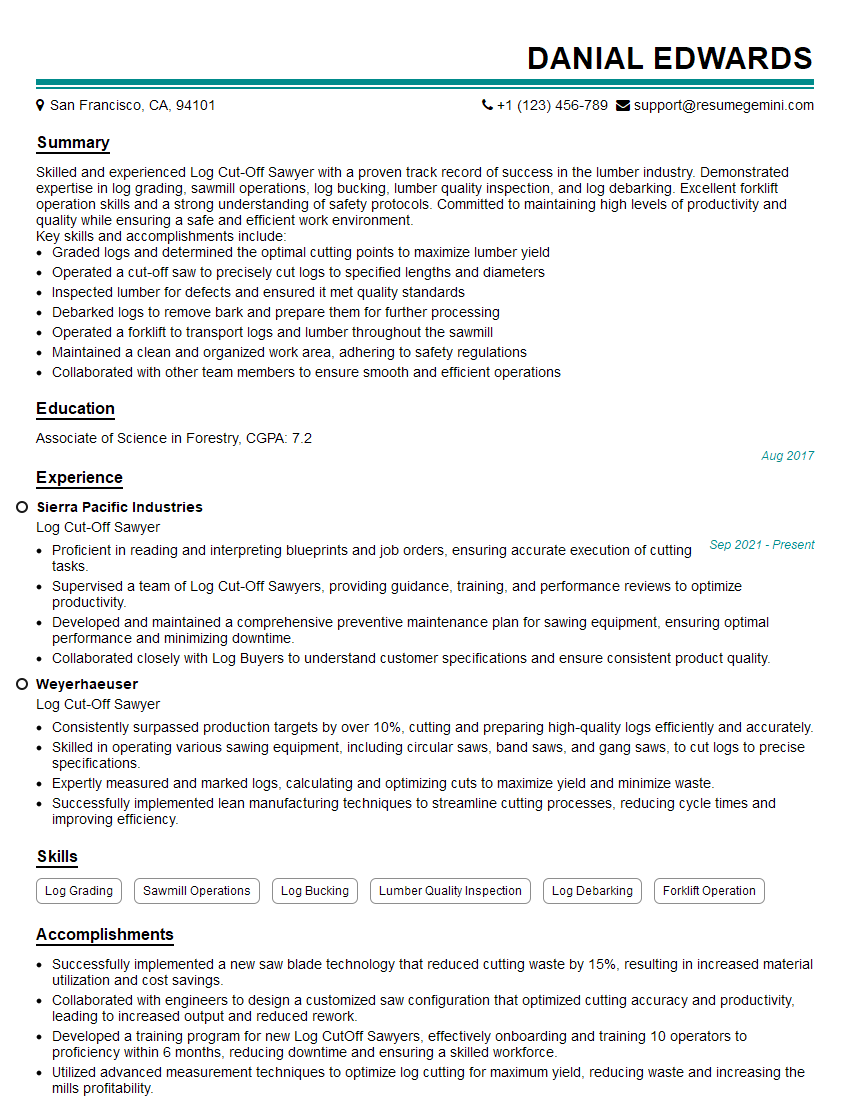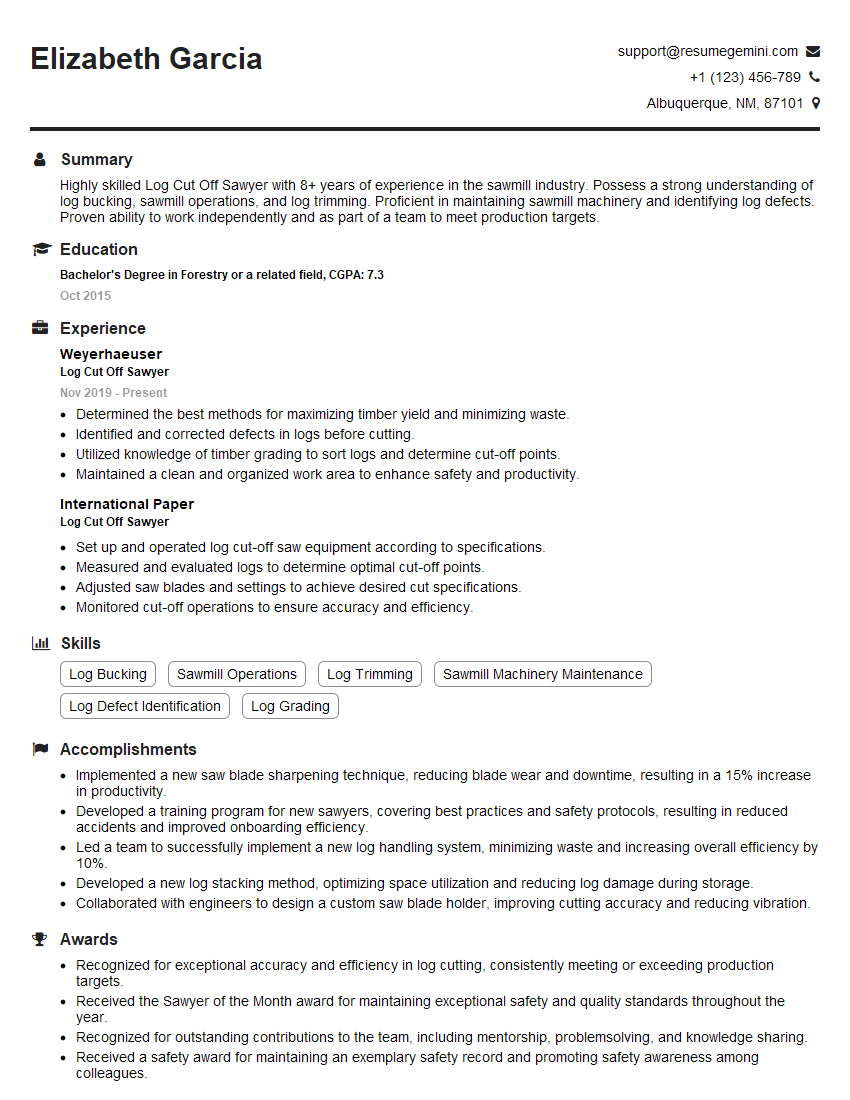Are you gearing up for a career shift or aiming to ace your next interview? Look no further! We’ve curated a comprehensive guide to help you crack the interview for the coveted Log Cut-Off Sawyer position. From understanding the key responsibilities to mastering the most commonly asked questions, this blog has you covered. So, buckle up and let’s embark on this journey together
Acing the interview is crucial, but landing one requires a compelling resume that gets you noticed. Crafting a professional document that highlights your skills and experience is the first step toward interview success. ResumeGemini can help you build a standout resume that gets you called in for that dream job.
Essential Interview Questions For Log Cut-Off Sawyer
1. What are the primary responsibilities of a Log Cut-Off Sawyer?
As a Log Cut-Off Sawyer, my primary responsibilities include:
- Operating and maintaining a cut-off saw to cut logs into specified lengths.
- Measuring and marking logs for cutting, ensuring precise and consistent lengths.
- Adjusting saw blades and settings to achieve the desired cut quality.
- Loading logs onto the cut-off saw and removing cut pieces.
- Maintaining a clean and organized work area to ensure safety and efficiency.
2. What types of cut-off saws are commonly used for log cutting?
Circular Saw Blades
- Thin, circular blades with teeth around the circumference.
- Used for cutting through logs in a single pass.
- Require precise alignment and sharpening to ensure clean cuts.
Band Saws
- Continuous, flexible bands with teeth on one edge.
- Wrap around two or more wheels, creating a loop that cuts through logs.
- Capable of making intricate cuts and curves.
Chain Saws
- Portable saws with a chain of teeth attached to a guide bar.
- Used for cutting logs in the field or in tight spaces.
- Require proper handling and safety precautions.
3. How do you ensure the accuracy of log length measurements and cuts?
To ensure accuracy, I follow these steps:
- Using measuring tapes or rulers calibrated to industry standards.
- Marking logs clearly with chalk or paint to indicate the desired cut length.
- Adjusting the cut-off saw settings precisely according to the measurements.
- Inspecting the cut pieces to verify they meet the specified tolerances.
- Regularly calibrating the cut-off saw and measuring equipment.
4. What safety precautions are crucial for Log Cut-Off Sawyers to observe?
As a Log Cut-Off Sawyer, safety is paramount, and I strictly adhere to the following precautions:
- Wearing appropriate personal protective equipment (PPE) such as gloves, safety glasses, and hearing protection.
- Inspecting the cut-off saw and work area before starting operations.
- Ensuring a stable and secure footing while operating the saw.
- Never placing hands or body parts near the cutting blade.
- Following proper lockout/tagout procedures when performing maintenance or repairs.
5. How do you handle defective or damaged logs?
When encountering defective or damaged logs, I take the following steps:
- Identifying the defect or damage and assessing its severity.
- Marking the log clearly to indicate the issue.
- Separating the defective log from the good ones to prevent further damage.
- Reporting the defect to the supervisor or quality control personnel.
- Following instructions on how to handle the defective log, whether it needs to be discarded or repaired.
6. What maintenance tasks are essential for cut-off saws?
To ensure the proper functioning and safety of cut-off saws, regular maintenance is crucial. I perform the following tasks:
- Cleaning and lubricating moving parts, such as bearings and gears.
- Inspecting saw blades for wear and tear, and replacing them as needed.
- Adjusting blade tension and alignment to maintain optimal cutting performance.
- Checking electrical connections and wiring to ensure there are no faults.
- Following manufacturer’s guidelines for maintenance intervals and procedures.
7. How do you optimize the efficiency of log cutting operations?
To enhance efficiency, I implement the following strategies:
- Sharpening saw blades regularly to ensure clean and precise cuts.
- Optimizing log placement on the cut-off saw to minimize waste.
- Minimizing setup time by having tools and materials readily available.
- Maintaining a well-organized work area to reduce downtime.
- Working with other team members to streamline the cutting process.
8. What troubleshooting steps do you take if the cut-off saw malfunctions?
When the cut-off saw malfunctions, I take the following troubleshooting steps:
- Identifying the potential cause of the malfunction, such as power issues, blade problems, or mechanical failures.
- Shutting down the saw and disconnecting it from the power source.
- Visually inspecting the saw for any obvious issues or damage.
- Checking electrical connections and wiring for any loose or frayed components.
- Consulting the manufacturer’s manual for specific troubleshooting guidance.
9. How do you maintain a positive and collaborative work environment with other team members?
To foster a positive and collaborative work environment, I:
- Communicate clearly and effectively with team members, ensuring everyone understands their roles and responsibilities.
- Offer assistance and support to colleagues whenever possible.
- Respect the opinions and perspectives of others, even if they differ from my own.
- Share knowledge and expertise, contributing to the overall growth and success of the team.
- Maintain a positive and upbeat attitude, even under pressure.
10. What career goals have you set for yourself as a Log Cut-Off Sawyer?
As a Log Cut-Off Sawyer, my career goals include:
- Becoming a highly skilled and experienced sawyer, producing consistently high-quality logs.
- Learning advanced techniques and mastering different types of cut-off saws.
- Assuming leadership roles and mentoring junior sawyers.
- Contributing to the optimization of log cutting operations, improving efficiency and safety.
- Pursuing opportunities for professional development and certification, staying up-to-date with industry best practices.
Interviewers often ask about specific skills and experiences. With ResumeGemini‘s customizable templates, you can tailor your resume to showcase the skills most relevant to the position, making a powerful first impression. Also check out Resume Template specially tailored for Log Cut-Off Sawyer.
Career Expert Tips:
- Ace those interviews! Prepare effectively by reviewing the Top 50 Most Common Interview Questions on ResumeGemini.
- Navigate your job search with confidence! Explore a wide range of Career Tips on ResumeGemini. Learn about common challenges and recommendations to overcome them.
- Craft the perfect resume! Master the Art of Resume Writing with ResumeGemini’s guide. Showcase your unique qualifications and achievements effectively.
- Great Savings With New Year Deals and Discounts! In 2025, boost your job search and build your dream resume with ResumeGemini’s ATS optimized templates.
Researching the company and tailoring your answers is essential. Once you have a clear understanding of the Log Cut-Off Sawyer‘s requirements, you can use ResumeGemini to adjust your resume to perfectly match the job description.
Key Job Responsibilities
The Log Cut-Off Sawyer is responsible for cutting logs to the specified lengths and dimensions, ensuring that the cut logs meet the required specifications and quality standards.
1. Log Cutting
• Cutting logs to precise lengths and dimensions using specialized cutting equipment.
• Operating and maintaining log cutting machinery and equipment.
• Inspecting logs for defects and identifying suitable cutting points.
2. Log Handling
• Loading and unloading logs from cutting equipment and work areas.
• Stacking and sorting cut logs according to specifications.
• Maintaining a clean and organized work area.
3. Quality Control and Monitoring
• Measuring and inspecting cut logs to ensure they meet specifications.
• Identifying and reporting any defects or non-conformities.
• Maintaining records of cut logs and production.
4. Safety and Compliance
• Following all safety regulations and procedures.
• Using personal protective equipment and ensuring a safe work environment.
• Reporting any safety hazards or concerns.
Interview Tips
Preparing for a Log Cut-Off Sawyer interview requires a combination of technical knowledge and a focus on safety and quality. Here are some tips to help you ace the interview:
1. Research the Company and Position
• Thoroughly research the company and the specific role, including its responsibilities and requirements.
• Familiarize yourself with the company’s industry, products, and values.
• This will demonstrate your interest and enthusiasm for the position.
2. Highlight Relevant Skills and Experience
• Emphasize your technical skills in log cutting and handling, including your proficiency in operating various cutting machines.
• Highlight your experience in quality control and ensuring adherence to specifications.
• Showcase your commitment to safety by mentioning any relevant certifications or safety training.
3. Quantify Your Accomplishments
• Use specific numbers and metrics to quantify your accomplishments in previous roles.
• For example, mention how you improved production efficiency or reduced waste.
• Quantifying your results will provide tangible evidence of your contributions.
4. Prepare for Safety and Quality Questions
• Be prepared to discuss your understanding of safety protocols and regulations in the logging industry.
• Explain your approach to ensuring the quality of cut logs, including your methods for measuring and inspecting.
• This demonstrates your commitment to maintaining a safe and productive work environment.
5. Dress Professionally and Be Punctual
• Dress professionally and arrive on time for your interview.
• This conveys respect for the interviewer and the company.
• Being punctual shows that you value punctuality and reliability.
Next Step:
Armed with this knowledge, you’re now well-equipped to tackle the Log Cut-Off Sawyer interview with confidence. Remember, a well-crafted resume is your first impression. Take the time to tailor your resume to highlight your relevant skills and experiences. And don’t forget to practice your answers to common interview questions. With a little preparation, you’ll be on your way to landing your dream job. So what are you waiting for? Start building your resume and start applying! Build an amazing resume with ResumeGemini.

